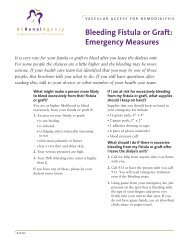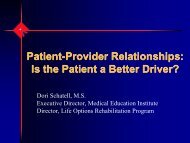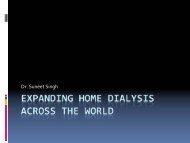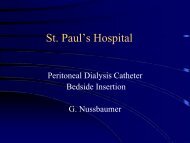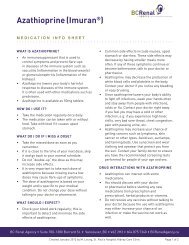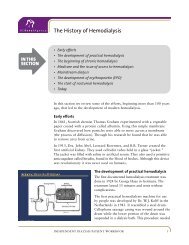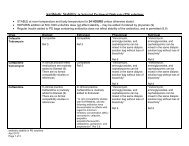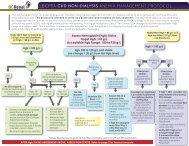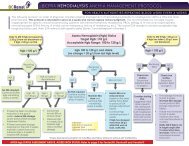RESTLESS LEG SYNDROME - BC Renal Agency
RESTLESS LEG SYNDROME - BC Renal Agency
RESTLESS LEG SYNDROME - BC Renal Agency
You also want an ePaper? Increase the reach of your titles
YUMPU automatically turns print PDFs into web optimized ePapers that Google loves.
Restless Leg Syndrome (RLS) Treatment Algorithmfor Hemodialysis PatientsSupplemental Evidence for Treatment OptionsRLS should only be treated if patients have severeand bothersome symptoms which impair their sleepor quality of life. In terms of non-pharmacologicalstrategies, correct iron deficiency, if applicable, asiron is a cofactor in dopamine production. Considera trial of abstinence from alcohol, caffeine andnicotine. Rule out any offending medication(s)that may be contributing and reducing the doseor discontinuing, if feasible. Refer to the list ofoffending medications in algorithm. Consider a trialof mental alerting activities, such as video games orcrossword puzzles, to reduce symptoms at times ofboredom.In terms of pharmacotherapies, available literaturein hemodialysis patients is limited. Most studiesare of small sample size, from single centre,have significant drop-outs and short follow-up.Recommendations are largely extrapolated from thegeneral population and based on expert opinions.EVIDENCELevodopaIn a randomized, double-blind, placebo-controlled,crossover trial 1 of 5 hemodialysis patients withuremic RLS, levodopa/carbidopa 100/25 mg 1 hourbefore HS was compared to placebo x 1 week with1-week washout. There was no consistent subjectiveimprovement in sleep quality, sleep latency, thenumber of awakenings or RLS symptoms. The meanpercentage of periodic limb movement (PLM) whileasleep was 15.1 ± 4.9% with placebo and decreasedto 8.6 ± 4.0% with levodopa/carbidopa (p=0.014). Themean PLM index while asleep was 101.0 ± 29.1 withplacebo and was significantly decreased to 61.0 ±28.3 with levodopa/carbidopa (p=0.006).In another randomized, double-blind, placebocontrolled,crossover trial 2 of 11 HD patients,levodopa/benserazide 100/25 mg to 200/50 mg 1hour before HS compared to placebo x 2 weekswithout washout was shown to improve fewnocturnal awakenings, sleep quality, generalcondition and quality of life and to decrease severityof RLS, respectively. No severe adverse effectsreported.Wetter et al 3 showed that levodopa was moreeffective than placebo in reducing PLM index andimproving sleep quality in a randomized, doubleblind,placebo-controlled, crossover trial of 11uremic patients with RLS.PramipexoleIn an open label 4 of 10 hemodialysis patients withRLS with 8 month follow-up, pramipexole showedan improvement in the International Restless LegStudy Group (IRLSSG) severity scale and PLM indexduring sleep and while awake. Pramipexole wasprescribed at an initial dose of 0.125 mg, 2 hoursbefore sleep, with an optional upward titrationaccording to response and tolerance to a maximumdaily dose of 0.75 mg, with one dose taken at least2 hours before dialysis. Nine patients showed aresponse within the first week with a mean dose of0.25 mg per day. Domperidone was prescribed tocontrol side effects. The mean score in the severityscale fell from 25.8 ± 5.75 (in the severe range) in thepretreatment evaluation to 7.7 ± 8.36 after treatment(p< 0.005). Sleep latency, total hours of sleep,number of awakenings, and sleep efficiency showedno significant change.RopiniroleIn an open label, prospective, randomized, controlledcrossover trial 5 of 10 hemodialysis patients,ropinirole was shown to be superior to levodopa SRin reducing 6-item IRLS score, 16.6±2.8 to 4.4±3.8vs. 16.7±3.2 to 11.1±4,respectively (p
Restless Leg Syndrome (RLS) Treatment Algorithmfor Hemodialysis PatientsSupplemental Evidence for Treatment Optionshealth, body pain and social function (P
Medications for Restless Leg SyndromeDOPAMINERGIC AGENTSLevodopa/Carbidopa (Sinemet ® )Mechanism of ActionPharmacokineticsAdverse EffectsDosing Guidelines(Normal <strong>Renal</strong> Function)<strong>Renal</strong> Dosing GuidelinesGFR (mL/min)Levodopa is a dopamine precursor; carbidopa inhibits the peripheral breakdownof levodopa by inhibiting its decarboxylation, and thereby increases availablelevodopa at the blood brain barrier.Bioavailability of levodopa is 70-75% for controlled release formulation comparedto immediate release tablets. Should not be taken with high protein food formaximal absorption. Extensively metabolized; levodopa metabolites (activeand inactive) and 50% carbidopa are renally excreted. Time to peak 30 minutesfor immediate release and 2 hrs for controlled release tablets. Half-life 1.5 hrs(levodopa) and more prolonged with controlled release formulation.Agitation, confusion, dizziness, sedation, orthostatic hypotension, dyspepsia,nausea; Morning rebound (recurrence of RLS in early morning) 20-35%;Augmentation (worsening of RLS symptoms, including earlier onset of symptoms,increased intensity or spread of symptoms to the arms) 80%. The risk ofaugmentation increases with levodopa dose ≥ 200 mg per day and may be lowerwith intermittent use (e.g. 50 (mL/min) 10 to 50 (mL/min)
Medications for Restless Leg SyndromeDOPAMINERGIC AGENTSPramipexole (Mirapex ® )Mechanism of ActionNon-ergot dopamine agonist: stimulates dopamine activity in stratium andsubstantia nigra.PharmacokineticsAdverse EffectsDosing Guidelines(Normal <strong>Renal</strong> Function)Rapid and almost complete absorptionProtein binding 15%Metabolism 90%Half-life 8.5 hours, 12 hours (elderly)Time to peak 2 hours.Dose related: headache (16%), insomnia (9% to 13%), abnormal dreams (1-8%),lightheadedness, somnolence (6%), hallucinations (rare); hypotension (rare);nausea (11-27%), constipation; compulsive behaviour (rare); sleep attack - fallingasleep during activities without warning (rare but elderly male > 63 years ofage are at higher risk). Augmentation may occur with prolonged use but is lesscommon than levodopa.0.125 mg PO 2 hours prior to HS; increase dose by 0.125 mg every 3-7 days up to amaximum of 1.5 mg per day. Most patients require ≤0.5 mg per day.<strong>Renal</strong> Dosing GuidelinesGFR (mL/min)>50 (mL/min) 10 to 50 (mL/min)
Medications for Restless Leg SyndromeDOPAMINERGIC AGENTSRopinirole (Requip ® )Mechanism of ActionNon-ergot dopamine agonist: stimulates dopamine activity in stratium andsubstantia nigra.PharmacokineticsAdverse EffectsDosing Guidelines(Normal <strong>Renal</strong> Function)Bioavailability 45-55%First pass; Protein binding 45-55%Extensive hepatic metabolism via cytochrome 1A2 to inactive metabolitesExcreted unchanged 63 years ofage are at higher risk). Augmentation may occur with prolonged use but is lesscommon than levodopa.0.25 mg PO 2 hours prior to HS; increase by 0.125 mg q3-7days up to a maximumof 4 mg per day. Most patients require ≤2 mg per day.<strong>Renal</strong> Dosing GuidelinesGFR (mL/min)>50 (mL/min) 10 to 50 (mL/min)
Medications for Restless Leg SyndromeBENZODIAZEPINEClonazepam (Rivotril ® )Mechanism of ActionPharmacokineticsBinds to benzodiazepine receptors on the postsynaptic GABA; enhanced inhibitoryeffect of GABA on neuronal excitability by increased neuronal membranepermeability to chloride ions.Well absorbedProtein binding 85%Extensive hepatic metabolism via glucuronidation/sulfate conjugation50 (mL/min) 10 to 50 (mL/min)
Medications for Restless Leg SyndromeOTHERSClonidine (Catapres ® )Mechanism of ActionCentral alpha-2 adrenoreceptor agonist.PharmacokineticsNormal half-life 12 to 16 hours50% hepatic metabolism58% excreted unchanged.Adverse EffectsSedation, hypotension, dry mouth; abrupt discontinuation may lead to reboundhypertension.Dosing Guidelines(Normal <strong>Renal</strong> Function)Start with low dose - 0.05 mg PO HS<strong>Renal</strong> Dosing GuidelinesGFR (mL/min)>50 (mL/min) 10 to 50 (mL/min)
Medications for Restless Leg SyndromeOTHERSGabapentin (Neurontin ® )Mechanism of ActionSelective, high affinity for voltage gated calcium channels in the brain and dorsalhorn of the spinal cord; Reduces influx of calcium, thus inhibiting the release ofexcitatory neurotransmitters such as glutamate, noradrenaline, substance P andcalcitonin gene related peptide.PharmacokineticsSaturable oral bioavailability (900 mg-60%; 1200 mg-47%; 2400 mg-34%)Limited hepatic metabolism, 70-80% excreted unchanged in the urineNormal half-life 5-6.5 hours.Adverse EffectsSedation, confusion, incoordination, peripheral edema.Dosing Guidelines(Normal <strong>Renal</strong> Function)Start with 100 mg PO HS, then 100 mg TID, titrate gradually to effect and astolerated to a max of 3600 mg per day (in 4 divided doses).<strong>Renal</strong> Dosing GuidelinesGFR (mL/min)>50 (mL/min) 10 to 50 (mL/min)
Medications for Restless Leg SyndromeOTHERSPregabalin (Lyrica ® )Mechanism of ActionSelective, high affinity for voltage gated calcium channels in the brain and dorsalhorn of the spinal cord; Reduces influx of calcium, thus inhibiting the release ofexcitatory neurotransmitters such as glutamate, noradrenaline, substance P andcalcitonin gene related peptidePharmacokineticsOral bioavailability 90%Limited hepatic metabolism, 90% excreted unchanged in the urineNormal half-life 5-6.5 hours.Adverse EffectsSedation, confusion, incoordination, peripheral edema.Dosing Guidelines(Normal <strong>Renal</strong> Function)Start with 25 mg PO HS, titrate to effect and as tolerated to a max of 300 mg POBID.<strong>Renal</strong> Dosing GuidelinesGFR (mL/min)>50 (mL/min) 10 to 50 (mL/min)





